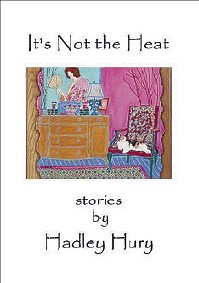A widower in Memphis, his children grown, receives what he terms “a gift”: news that he has pancreatic cancer (and an added gift: a renewed, profound recognition of his late wife’s love).
Another man: a psychologist, in midlife, in the car with his wife and teenage daughter, on their way from Bolivar to Memphis, recalls the ghost of the boy he once was and the girl who helped him see beyond his “fearful self-consciousness” (the same girl he loved, at 13, and lost).
And a woman, also in midlife: down from Memphis to attend a wedding in Mississippi, meets again a man and recalls that for a few months, 21 years ago, the couple had been “something.” “Untranslatable and ecstatic then,” she thinks, “now it was merely untranslatable.”
Highlights, then — revelations, really — from midlife and drawn from the first three stories in the short-story collection It’s Not the Heat (iUniverse) by Hadley Hury, a Memphian, a former film critic for this newspaper, and today the chair of the department of English at Hutchison.
Is there a shared theme throughout these and the seven additional stories in the collection? Not according to the author.

“The questions each story raises, as well as the sense of discovery, for me, changes with each of them,” Hury says. “I didn’t envision or intend one overarching theme. That said, I can perceive one possible correlative running through at least most of them. How to state it? I can think of two borrowings. One from Emily Dickinson: ‘That Love is all there is,/is all we know of Love.’ And one from Iris Murdoch: ‘Hope calmly and believe in love.'”
But add to Dickinson and Murdoch some words from Eudora Welty (and make them the epigraph that opens It’s Not the Heat): “The events in our lives happen in a sequence in time, but in their significance to ourselves they find their own order: the continuous thread of revelation.”
Revelation then, and again, and in Hury’s work, you’re likely to find it in the unlikeliest places:
A couple, their two children grown, worry over then welcome the arrival of their son’s partner (for life?), another man (“All We Know of Love”). Or a couple, late in life, grow concerned with then rescue the neglected boy who lives down the street (“Along the Border”). Or an Episcopal priest, happily married but given to self-questioning, recalls a boyhood friend then finds himself adopting the voice of the King himself, Elvis (“Till It Hurts”). Revelatory and significant, then, according to the order of events, but for an author who’s already written one novel (The Edge of the Gulf ), does form follow function? Translation: How do the requirements of a novel compare to the requirements of the short story?
“Whole different ball game,” Hury believes. “The novel is a commitment of a different sort of focus, of exploration, of narrative resources. What I loved about the stories in It’s Not the Heat is that with each one a different partnership begins to develop as one works. At times, I guide the story — and that affords a pleasant, even if delusional, sense of mastery. And at times the story guides me.
“As with any partnership, the sense of power and play, of give and take, changes hands over and over again through the process. That makes it fun and exciting. And that’s where my sense of discovery emerges — as I hope it may, in differing ways, for readers.”
But if you’re looking for discovery along autobiographical lines — a line that readers (and reviewers) often seek and writers just as often seek to sidestep — look again. According to Hury:
“You can take the writer out of his autobiography, but you can never take every shred of the autobiography out of the writer. However, what may be there in this regard are all shards — no whole pieces — and they are almost always transformed in the fictive process.”